A vigorous, long-blooming catmint. An excellent choice for pollinators. Can seed out aggressively. Firewise.
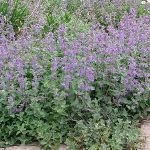
- Catmint
- 5
- Sun/part shade
- 15" x 15"
- Mediterranean


A vigorous, long-blooming catmint. An excellent choice for pollinators. Can seed out aggressively. Firewise.
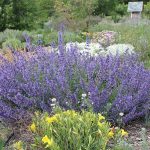
A vigorous, long-blooming catmint, great choice for pollinators. Will not spread by seed.
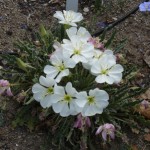
Fragrant Evening Primrose: Silken white blossoms unfurl each evening over shiny deep green mounds of leaves, slipping to a rosy tint with midday heat. The fragrance is sweet and exotic, contrasting sharply with the native surroundings of dry foothills, shrub steppe and pinyon-juniper. Tolerant of poor well-drained soils, and clay. Firewise. More information here.
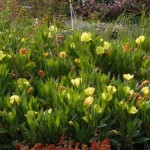
Missouri Evening Primrose grows into mounds of glossy leaves followed by clear yellow blossoms over much of the summer. Plants sprawl widely then die back to the ground in winter. Firewise.
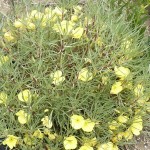
Fremont’s Evening Primrose produces a dazzling display of lemon-yellow flowers in mid-summer. Blooms are tucked in and around the narrow gray- green foliage. Deeply tap-rooted and long-lived. Needs good drainage. Firewise.
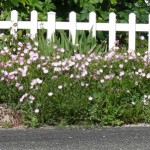
Showy Evening Primrose is a heat-loving beauty, thriving in sunny, dry areas. It can spread rapidly on shallow roots and can overrun smaller, less vigorous plants. Preferring unimproved, well-drained soils, this plant requires little extra water once established. Firewise. More information here.
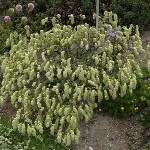
Hopflower Oregano is an outstanding mounding or draping plant, producing hundreds of small lantern-like flowers on wiry stems. Terrific for edging, cascading over walls or filling in between larger plants.
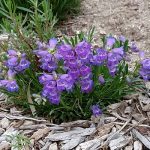
Unusual and rare Penstemon with outstanding landscape value. Low tufts of narrow, dark green leaves persist through the winter then erupt in purple flowers in early spring. Firewise. Choice!
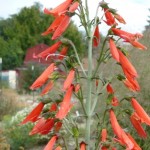
Loose spikes of brilliant scarlet tubular flowers with distinctive ‘bearded’ lip. Tough and long-lived. Attracts hummingbirds. More information here.
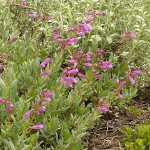
Waxy blue green leaves and large lavender tubular flowers. Semi-woody structure. Prefers part shade. Firewise.
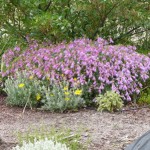
Davidson’s Penstemon is a choice landscape plant with a low, sprawling woody structure that allows it to function like a ground cover. If given some sun protection in winter it will be completely evergreen. Lavender tubular flowers show up in late spring. Likes well-drained soils. Firewise.
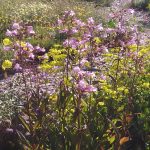
A substantial penstemon with spikes of white to pale pink flowers in June. Unlike most penstemons, it prefers slightly moist, well-drained soil in full sun or part shade. Firewise.
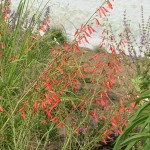
Firecracker Penstemon bears tubular, bright scarlet flowers over dark green basal leaves. Prefers poor to moderately fertile, well drained soil and full sun. Great for dry desert-scapes. Pollinators: hummingbirds and bees. Firewise.
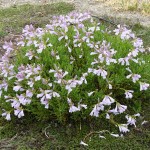
Shrubby Penstemon is an unusual woody, upright, evergreen penstemon with abundant lavender tubular flowers in early summer. Foliage turns soft yellow in autumn with purple-green flower spikelets. Leaves may burn in winter–shade helps. Firewise.
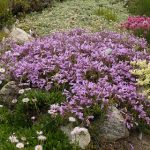
Dwarf Shrubby Penstemon is a compact version of the native Shrubby Penstemon and quite similar to Davidson’s Penstemon. Gorgeous lavender flowers in late spring. Evergreen mounds are beautiful in winter. Charming! Firewise.
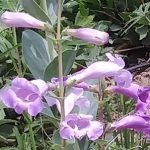
One of the showiest of all North American native Penstemons, Penstemon grandiflorus can reach heights of three feet with stunning pink to purple flowers. The plant’s beautiful vertical structure and succulent gray-green foliage, make it a very unique Penstemon. Firewise. More information here.
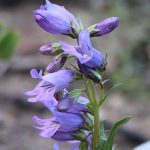
Clumps of bright purple flowers arise from dense tufts of linear leaves. Occurs in the wild at higher elevations in Colorado, but given some irrigation it tolerates cultivation in lower, warmer climates
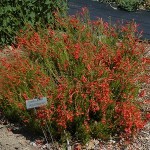
Pineleaf Penstemon has loads of red-orange tubular blooms over expanding clumps of attractive narrow leaves. Stems become woody with age. Evergreen foliage. Firewise. More information here.
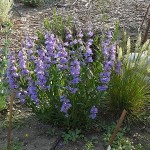
Showy spikes of purple-blue flowers in mid-spring. Flowers are huge and attractive to bees. Firewise.
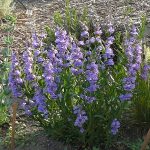
Showy spikes of purple blowers in late spring. The large flowers attract bumblebees.
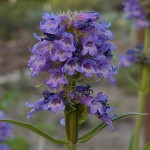
This early blooming penstemon sends up multiple stalks, each with numerous whorls of small tubular flowers. Widespread native. Firewise.
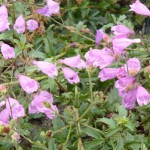
Richardson’s is a wonderful and easy Penstemon for filling in spaces in the garden or tumbling down banks on trailing stems. Unlike most penstemons, this one starts blooming late, producing a charming profusion of rosy purple flowers that lasts from early summer nearly until frost. It re-seeds readily and multiplies in the garden. Firewise.
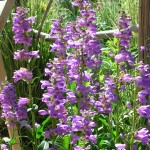
Rocky Mountain Penstemon has violet-blue flower spikes over leathery foliage. Attracts hummingbirds. Long-lived, reliable bloomer. Forms low evergreen clumps, easy and reliable; deadhead for re-bloom. Pollinators: bees. Firewise.
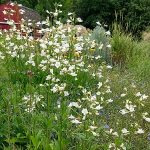
Pure white flowers on tall stems in early summer. This clump-forming penstemon grows wild on dryish soils in prairies and open woods. Attractive to hummingbirds, butterflies and bees.
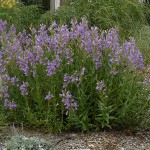
Lovely Penstemon is a vigorous evergreen native penstemon with large, gorgeous tubular lavender flowers in late spring. Cut back seed heads to encourage re-bloom. Pollinators: bees. Firewise.
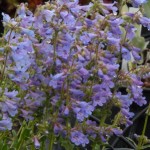
Blue Mist Penstemon or Front Range Penstemon is a dwarf penstemon, native to the plains and foothills of the Eastern Rockies, often growing in large colonies. In late spring, dainty spikes of lavender-blue flowers rise over evergreen rosettes Likes dry, well- drained soil and is well adapted to garden conditions. Firewise.
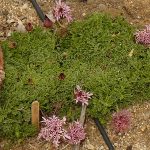
Charming, low-growing rock garden plant or small-scale groundcover. Finely cut evergreen foliage creeps across the ground, sprouting pincushion-like mauve flowers in late spring. Attractive seedhead tufts follow.
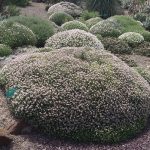
Intricately branched wiry shrublet forming somewhat prickly mound-like cushions. Completely covered with soft pink flowers in late spring.
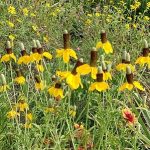
This cheerful wildflower has two forms, one yellow and one red. They both will bloom over a long period in hot, dry summers, attracting bees and butterflies. Great in meadows and other casual landscapes. Will seed around.
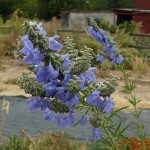
Azure Blue Sage is a tall, late-blooming Salvia. Brilliant blue tubular flowers on slender, arching stems provide dramatic late- season color in the garden. Disappears in winter and comes booming back from the roots in spring. Great late-season food source for bumble bees, honey bees, butterflies and hummingbirds! Tolerates clay. Firewise. More information here.
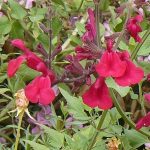
A stunningly beautiful Salvia from high in the mountains of N. Mexico. Attracts hummingbirds, bees. Firewise.
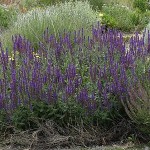
Blue Queen Salvia has spikes of violet-blue flowers in summer; tolerates intense heat and drought. Cut back after bloom for quick re-bloom. Magnet for honeybees and butterflies! Tolerates clay. Firewise.
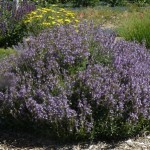
Dwarf Culinary Sage grows into a shrub covered with a dense mound of edible leaves. Covered with showy lavender-blue flowers in early summer, it becomes a magnet for honeybees. Unlike ordinary culinary sage, this dwarf form is completely evergreen, creating a beautiful gray-green mound in the winter garden. Tolerates clay and shade. Firewise.
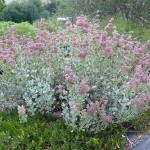
Giant Flowered Purple Sage is a tough, heat-tolerant summer-bloomer with spectacular clumps of deep purple flowers.Attractive gray-green foliage remains in winter. Needs well-drained soil. Attractive to bees, butterflies and hummingbirds. Tolerates clay. More information here.
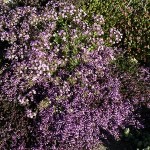
Rock Soapwort is a vigorous, mounding plant, covered with small pink flowers in the spring. Beautiful for edging a sunny border or spilling over rock walls or the edges of large planters. To maintain a compact habit, prune plants back hard immediately after blooming. Firewise.
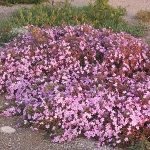
Late blooming, vigorous groundcover with large light purple flowers. Large-scale groundcover. Firewise.
Prairie Skullcap has neat mounds with tight, upright stems. Stunning deep lavender-blue flowers dotted with white, May through July.
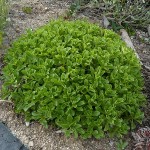
This compact mounding sedum is very useful in the landscape for small border areas and evergreen structure. Grown for foliage rather than flowers. Firewise.
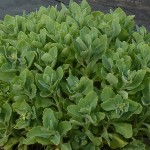
This large, mounding sedum blooms pink in the fall. Earlier in the summer, its handsome mound of succulent leaves is a great addition to any xeriscape. Firewise.
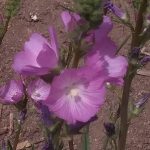
This native Checkermallow is a charming wildflower sporting dozens of small hollyhock-like blooms. Found in the wild in moist meadows, but it does well in moderately irrigated gardens. Supports native pollinators.